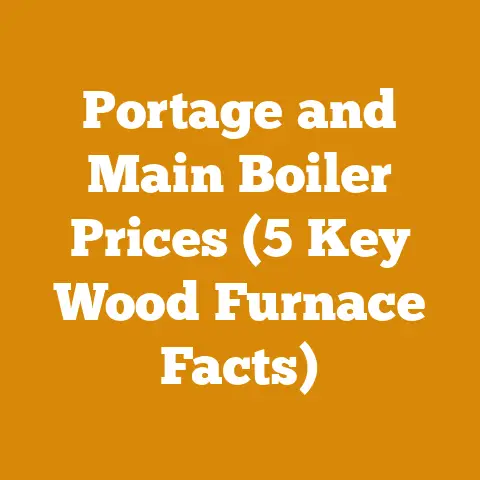Radiant Propane Heater for Garage (5 Pro Tips for Woodshops)
I’ve seen so many woodworkers make the same mistake when winter rolls around: they underestimate the importance of proper heating in their garage woodshops. They either tough it out in the cold (trust me, numb fingers and precise cuts don’t mix!) or they grab the first space heater they see at the local hardware store, without really considering if it’s the right fit for a dusty, flammable environment. That’s why I wanted to share my experiences, and some solid advice, about using radiant propane heaters – specifically tailored for woodshops.
Radiant Propane Heater for Garage (5 Pro Tips for Woodshops)
Radiant propane heaters offer a unique blend of efficiency and safety, especially in a space like a garage woodshop. They heat objects directly, rather than heating the air, which can be a huge advantage in a drafty environment. But, like any tool, they need to be used correctly. I’ve spent years refining my own woodshop setup, and heating has always been a critical component. This guide will cover what I’ve learned.
1. Size Matters: Calculating Your BTU Needs
Let’s be honest, slapping a heater into your woodshop and hoping for the best is a recipe for either freezing your tail off or wasting a ton of propane. The key is to understand British Thermal Units (BTUs). BTUs measure the amount of energy needed to raise the temperature of one pound of water by one degree Fahrenheit. For propane heaters, it’s a direct measure of their heating output.
How to Calculate Your Woodshop’s BTU Needs:
- Measure Your Space: Calculate the volume of your garage woodshop in cubic feet (length x width x height).
- Determine Temperature Rise: Decide how much you need to raise the temperature. For example, if it’s 30°F outside and you want your shop to be a comfortable 65°F, you need a 35°F temperature rise.
-
Use a Formula: A common rule of thumb is:
Cubic Feet x Temperature Rise x Factor = BTU Required- The “Factor” accounts for insulation. Here’s a breakdown:
- Poorly Insulated: Factor = 6
- Moderately Insulated: Factor = 4
- Well Insulated: Factor = 2
-
Example: Let’s say your woodshop is 20ft x 20ft x 10ft, poorly insulated, and you need a 35°F temperature rise.
-
Volume: 20 x 20 x 10 = 4000 cubic feet
-
BTU Required: 4000 x 35 x 6 = 840,000 BTU
-
Important Note: This result is likely unrealistic for a garage woodshop. It highlights the importance of insulation. If you can improve your insulation, you’ll drastically reduce your BTU needs.
- The “Factor” accounts for insulation. Here’s a breakdown:
Why This Matters:
- Efficiency: An oversized heater will cycle on and off frequently, wasting propane and creating uneven heating. An undersized heater will run constantly and struggle to maintain a comfortable temperature.
- Cost: Propane isn’t cheap. Correctly sizing your heater will save you money in the long run.
- Comfort: A properly sized heater will provide consistent, comfortable heat, allowing you to focus on your woodworking.
My Experience: When I first started out, I drastically overestimated the size of heater I needed. I ended up with a huge propane bill and a shop that was either sweltering or freezing, depending on the heater’s cycle. After properly calculating my BTU needs and adding some insulation, I was able to downsize my heater and save a significant amount of money.
2. Safety First: Essential Precautions for Radiant Propane Heaters
Woodshops are inherently hazardous environments. Sawdust, flammable finishes, and power tools create a perfect storm for accidents. Adding a propane heater to the mix requires extra vigilance.
Key Safety Precautions:
-
Ventilation is Non-Negotiable: Propane heaters produce carbon monoxide (CO), an odorless, colorless gas that can be deadly. Proper ventilation is absolutely essential.
- Carbon Monoxide Detectors: Install CO detectors in your woodshop and test them regularly. I have two, one near the heater and one near my workbench.
- Fresh Air Supply: Ensure adequate ventilation by opening a window or door. Check local codes for specific ventilation requirements.
- Never Use in Enclosed Spaces: Never operate a propane heater in a completely sealed room.
-
Clearance is Key: Radiant heaters get extremely hot. Maintain a safe clearance between the heater and any flammable materials, including wood, sawdust, rags, and finishing supplies.
- Manufacturer’s Recommendations: Always follow the manufacturer’s recommendations for clearance distances. These are typically specified in the owner’s manual.
- Visual Inspection: Regularly inspect the area around the heater for any potential fire hazards.
- Heat Shields: Consider using heat shields to protect nearby surfaces.
-
Propane Tank Storage: Store propane tanks outdoors, in a well-ventilated area, away from direct sunlight and heat sources.
- Secure the Tank: Secure the tank to prevent it from tipping over.
- Check for Leaks: Regularly check the tank and connections for leaks using a soapy water solution. If you smell propane, immediately turn off the gas and ventilate the area.
- Professional Inspection: Have your propane system professionally inspected annually.
-
Fire Extinguisher: Keep a fire extinguisher rated for Class A, B, and C fires readily accessible in your woodshop. Class A is for ordinary combustibles like wood and paper; Class B is for flammable liquids; and Class C is for electrical fires.
- Training: Make sure you know how to use the fire extinguisher properly.
- Regular Inspection: Inspect the fire extinguisher regularly to ensure it’s fully charged.
-
Never Leave Unattended: Never leave a propane heater unattended while it’s operating.
Data Points:
- According to the Consumer Product Safety Commission (CPSC), carbon monoxide poisoning from portable propane heaters is a significant safety hazard.
- The National Fire Protection Association (NFPA) provides detailed safety guidelines for the use of propane heaters.
My Close Call: I once got complacent about ventilation. I was working late in my shop, the door was closed, and I started feeling drowsy and nauseous. Luckily, my CO detector went off, and I immediately opened the door and got some fresh air. It was a sobering reminder of the dangers of carbon monoxide poisoning.
3. Choosing the Right Type of Radiant Propane Heater
Radiant propane heaters aren’t a one-size-fits-all solution. There are different types, each with its own advantages and disadvantages. Understanding the differences will help you choose the best heater for your woodshop.
Types of Radiant Propane Heaters:
-
Infrared Heaters: These heaters emit infrared radiation, which directly heats objects and people in their path. They are efficient and effective for spot heating.
- Pros: Efficient, quick heating, directional heat.
- Cons: Can create hot spots, not ideal for heating large areas evenly.
- Best For: Heating specific workstations or areas within the woodshop.
-
Tank Top Heaters: These heaters attach directly to a propane tank. They are portable and easy to use, but they can be less efficient and less safe than other types.
- Pros: Portable, inexpensive, easy to use.
- Cons: Less efficient, can be less safe due to direct tank connection, may require frequent tank refills.
- Best For: Short-term heating in small areas, emergency heating. I generally advise against these in woodshops due to their higher risk profile.
-
Forced Air Heaters: While technically not purely radiant, many propane forced air heaters also have radiant heating components. These heaters use a fan to circulate warm air, which can help to heat a larger area more evenly.
- Pros: Can heat larger areas, faster heating.
- Cons: Can stir up dust, can be noisy, less energy efficient than pure radiant heaters.
- Best For: Heating larger, less insulated woodshops. Requires careful attention to dust control.
Factors to Consider When Choosing a Heater:
- Woodshop Size: As discussed earlier, the size of your woodshop will determine the BTU output you need.
- Insulation: The level of insulation in your woodshop will significantly impact heating efficiency.
- Budget: Propane heaters range in price from a few hundred dollars to several thousand dollars.
- Safety Features: Look for heaters with safety features such as automatic shut-off, tip-over protection, and oxygen depletion sensors (ODS).
- Portability: Do you need a portable heater that can be easily moved around the woodshop?
- Noise Level: Some propane heaters can be quite noisy. If noise is a concern, look for a quieter model.
My Recommendation: For most garage woodshops, I recommend an infrared radiant propane heater with safety features like automatic shut-off and an ODS. These heaters provide efficient, directional heat and are relatively safe when used properly.
4. Optimizing Heat Distribution in Your Woodshop
Even with the right heater, you may still struggle to maintain a consistent temperature throughout your woodshop. Here are some tips for optimizing heat distribution:
-
Strategic Placement: Position the heater in a central location, away from flammable materials and obstructions. Experiment with different positions to find the optimal location for heat distribution.
- Angle the Heater: Angle the heater to direct heat towards the areas where you spend the most time.
- Avoid Obstructions: Make sure the heater’s radiant heat isn’t blocked by tools, equipment, or materials.
-
Fans: Use fans to circulate warm air and prevent hot spots. Ceiling fans are particularly effective for distributing heat evenly.
- Low Speed: Run fans on a low speed to minimize dust disturbance.
- Direction: Adjust the fan direction to push warm air down from the ceiling.
-
Insulation: As mentioned earlier, insulation is crucial for retaining heat. Insulate your walls, ceiling, and doors to minimize heat loss.
- Weatherstripping: Seal any gaps around doors and windows with weatherstripping.
- Insulated Curtains: Use insulated curtains to block drafts and retain heat.
-
Thermal Mass: Introduce thermal mass into your woodshop. Thermal mass materials, such as concrete, brick, or water-filled containers, absorb and store heat, helping to regulate temperature fluctuations.
- Dark Colors: Paint thermal mass materials in dark colors to maximize heat absorption.
- Placement: Place thermal mass materials in areas that receive direct sunlight or radiant heat.
-
Zone Heating: Consider using multiple smaller heaters to create zone heating. This allows you to heat specific areas of your woodshop as needed, rather than heating the entire space.
A Case Study: I worked with a small woodworking shop that was struggling with uneven heating. The shop was poorly insulated and had a single, oversized propane heater. We implemented the following changes:
- Improved insulation by adding weatherstripping and insulated curtains.
- Replaced the oversized heater with two smaller infrared radiant heaters.
- Installed ceiling fans to circulate warm air.
- Added thermal mass by painting the concrete floor a dark color.
The result was a significant improvement in heating efficiency and comfort. The shop owner reported a reduction in propane costs and a more consistent temperature throughout the workspace.
5. Dust Control: A Critical Consideration for Woodshops
Dust is the bane of every woodworker’s existence. It’s messy, it’s a health hazard, and it can be a fire hazard. Using a propane heater in a woodshop exacerbates the dust problem, as the heat can dry out the air and make dust particles more airborne.
Effective Dust Control Strategies:
-
Dust Collection System: Invest in a good dust collection system. This is the single most important step you can take to control dust in your woodshop.
- Central System: A central dust collection system is the most effective option, but it can be expensive.
- Portable System: A portable dust collector can be a more affordable option, especially for smaller woodshops.
- Tool-Specific Collection: Use dust collection attachments on your power tools.
-
Air Filtration: Use an air filtration system to remove airborne dust particles.
- HEPA Filter: Look for an air filtration system with a HEPA filter, which can remove 99.97% of particles 0.3 microns or larger.
- Placement: Place the air filtration system in a central location in your woodshop.
-
Regular Cleaning: Clean your woodshop regularly to remove accumulated dust.
- Vacuum: Use a vacuum cleaner with a HEPA filter to clean floors, walls, and equipment.
- Wet Wiping: Wipe down surfaces with a damp cloth to remove dust.
- Avoid Compressed Air: Avoid using compressed air to clean your woodshop, as this can stir up dust and make it more airborne.
-
Humidity Control: Maintain a moderate humidity level in your woodshop. Dry air can exacerbate dust problems.
- Humidifier: Use a humidifier to increase humidity levels.
- Monitor Humidity: Use a hygrometer to monitor humidity levels.
-
Finishing Techniques: Choose finishing techniques that minimize dust generation.
- Water-Based Finishes: Water-based finishes tend to produce less dust than oil-based finishes.
- Spray Finishing: Spray finishing can create a lot of overspray, which can contribute to dust buildup. Use a spray booth to contain overspray.
My Personal Tip: I use a combination of a central dust collection system, an air filtration system, and regular cleaning to keep my woodshop dust-free. I also wear a respirator mask whenever I’m working with power tools or finishing materials. It’s a bit of extra effort, but it’s worth it for my health and safety.
The Bottom Line: Using a radiant propane heater in your garage woodshop can be a safe and effective way to stay warm during the winter months. However, it’s important to follow these five pro tips to ensure your safety and comfort. By properly sizing your heater, taking essential safety precautions, choosing the right type of heater, optimizing heat distribution, and controlling dust, you can create a warm, safe, and productive woodworking environment. Now, get out there and build something amazing!






